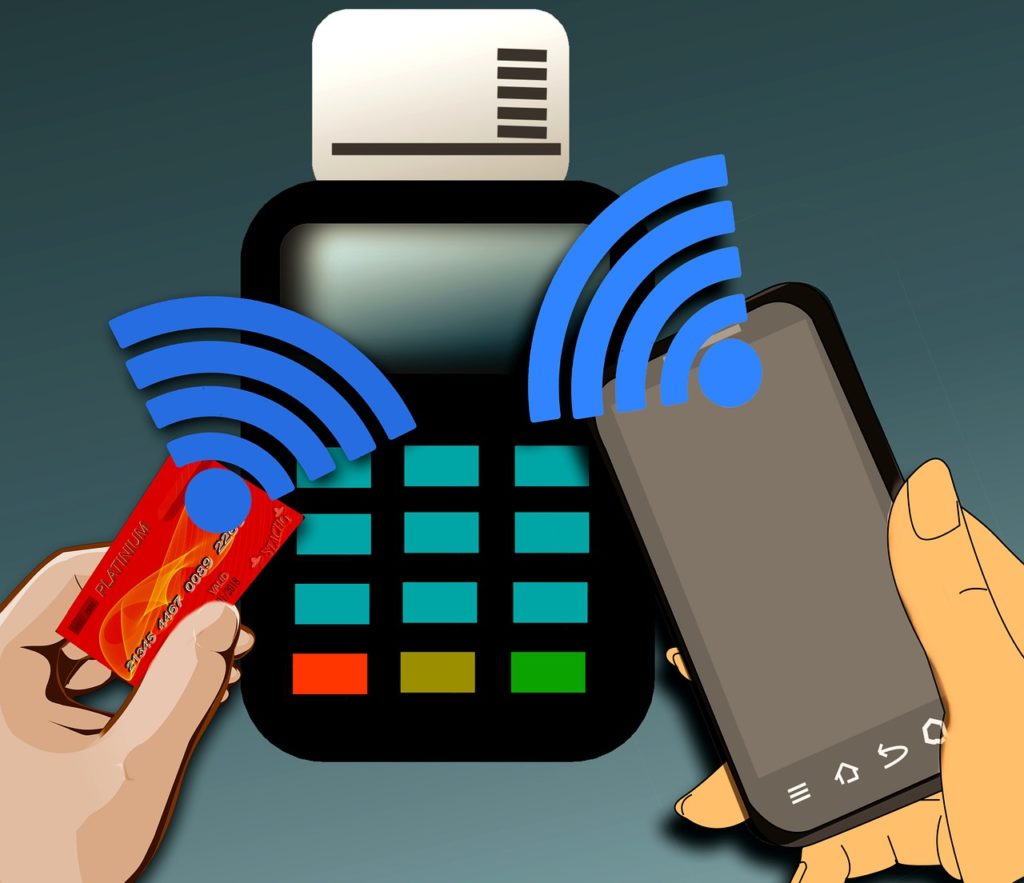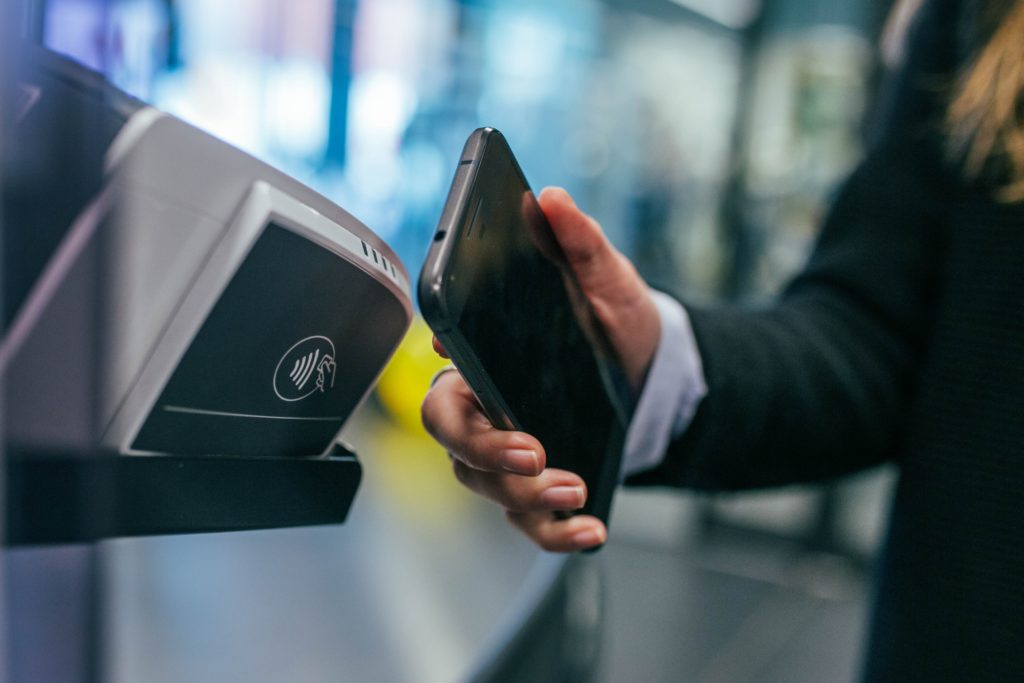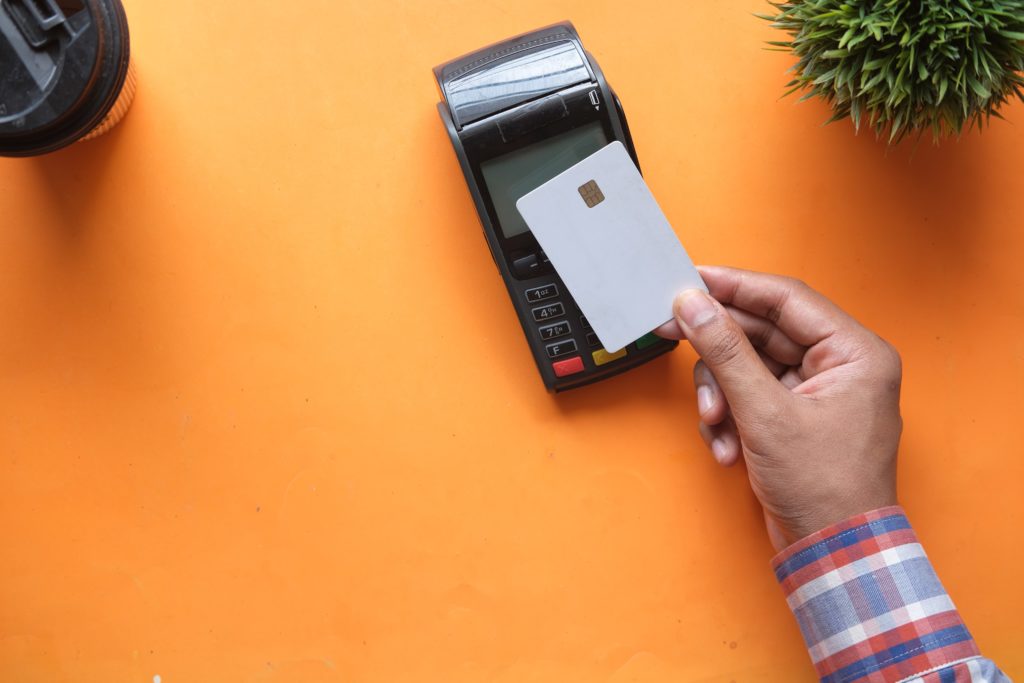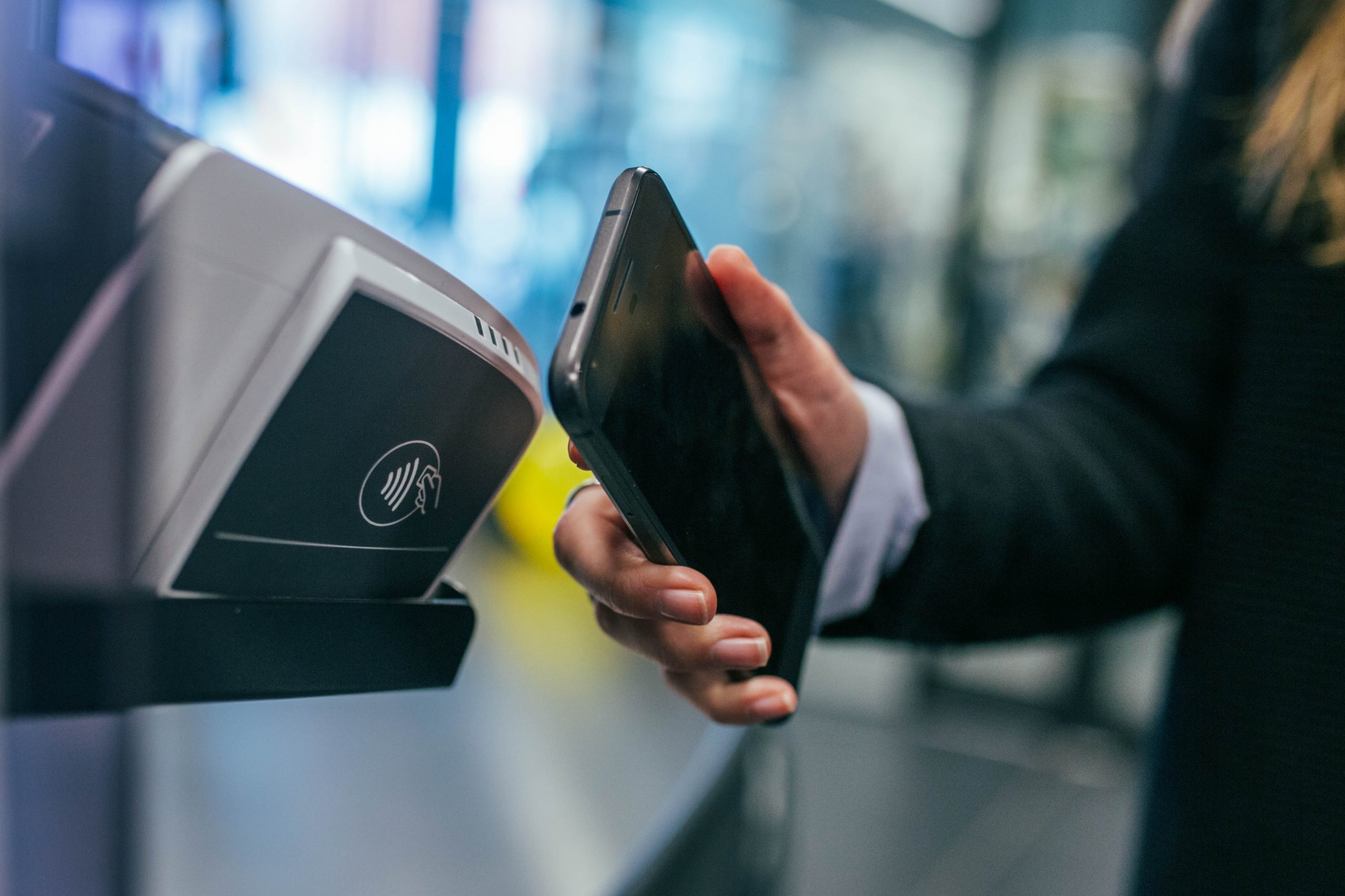Near Field Communication (NFC) has become a household name in the tech world. And every time a new technology is introduced, people have lots of questions. So, what exactly is NFC and how does it work? Today we’ll talk about NFC and why it is relevant to your tech buying decision process. Let’s first define it and then we shall discuss it in detail.
Quick Navigation
Near Field Communication (NFC) Defined

Near Field Communication is a high frequency wireless communication standard that allows short-range data exchange between two compatible devices such as a phone and a device equipped with an NFC reader. For NFC to work, the devices have to be within a few centimeters: Four to five centimeters is a typical range. This is different from far field communication which allows exchange of data across a wider range.
What makes NFC unique is that it as an intuitive interface and it allows different networking platforms to interoperate seamlessly.
How Does NFC Work?
Your NFC compatible device or smartphone sends out radio frequency signals. NFC is a subset of RFID (Radio Frequency Identification). RFID allows us to identify things through radio waves. NFC operates at a specific RFID Frequency. (13. 56 MHz).
The most common uses of NFC technology is in identification cards that allow access to different buildings and offices. However, they are increasingly now used in contactless payments. If you’ve shopped at large retailers like Office Depot or Whole Foods, you’ve probably used contactless payment. In contactless payment systems, there is no contact between a device such as your smartphone and the payment terminal. This means that you are required to only hold up or tap your phone to pay. For a seamless contactless payment, hold your phone two inches (4 to 5 centimeters) or closer to the reader.
When you initiate a contactless payment by holding or tapping your device to the payment terminal, the NFC technology starts to work. NFC uses the radio frequency to create a signal for passing encrypted information back and forth between your device and reader. The NFC tag is passive and can only receive information. On the other hand, your smartphone is active and can send and receive information.
One of the best things about NFC is Speed. NFC transactions take a fraction of seconds making it faster than cash when it comes to payment. NFC transfers data at a speed of up to 424Kbit/Second.
What are NFC Modes of Operation?
NFC technology has four modes used in different communication scenarios:
- NFC Card Emulation Mode for contactless payment. These devices emulate NFC tags or cards.
- NFC Reader/Writer Mode e.g . NFC devices that read and write such as reading smart posters
- Peer to Peer Mode. This mode allows two NFC devices to exchange information.
- Wireless Charging Mode. This mode allows NFC devices to charge small Internet of Things (IoT) devices.
What is an NFC tag?
An NFC tag has a microchip that stores information to transfer to an NFC device like your smartphone. The tag is placed on or in various places such as wristbands, posters, and stickers.
What Information Can an NFC tag store?
NFC tags store different types of information such as a web address or phone number. The tags have different memory capacity which dictates what you can and cannot store. This is usually between forty and one hundred and thirty characters.
How Can I program an NFC tag?
NFC tags are programmable. There are Android, Windows mobile and tablets that allow you to program and reprogram your NFC tag. You can reprogram these tags as many times as you wish but once you lock it, it can’t be reprogrammed.
Do NFC Tags Need Battery?
No. NFC tags get charged by being near an NFC enabled device such as your smartphone.
Does NFC TAGS Reduce Battery Life?
For NFC to work, your phone has to power an electromagnetic field which communicates with the NFC tags. This does not impact your phone battery. Besides, NFC is only active when you use your phone and deactivates when you lock the screen
Are NFC Tags Secure?
You can lock or password-protect NFC tags. This prevents the tag from being rewritten.
Why Can’t My NFC Device Read NFC Tags?
Here are possible reasons why your NFC device can’t read NFC tags.
- The NFC tag is not of the recommended NDEF Standards.
- Your device is not NFC enabled.
- The NFC tag is blank
- The NFC tag is disabled or broken.
What does NDEF Mean?
NDEF is an acronym for NFC Data Exchange Format. These are the set standards that ensure you can exchange information between compatible NFC tags and devices.
Is My Phone an NFC Tag or reader?
Your phone can function as both an NFC tag and NFC reader. This depends with the device that it is communicating with. For instance, when communicating with an NFC tag, they function as reader. However, when making payments at a contactless point of sale, the function as an NFC tag.
Who Controls NFC standards?
The NFC forum controls NFC protocols and standards. The NFC Forum is a non-profit organization that aims at improving and standardizing NFC technology. It also educates users on the benefits of NFC.
When was NFC Invented?
It is not clear when NFC was invented because it is only an advancement of Radio Frequency Identification. However, NFC has been around for a decade and they are gaining more popularity. This is driven by the fact that NFC chips have become more affordable. Now that it is possible to include them in your phone at a reason price, we expect that its popularity will continue to grow.
What are the Primary Uses of NFC?

NFC aims to:
- Connect different electronic devices such as a headset with your mobile phone.
- Allow access to digital content through wireless devices.
- Make contactless transactions, such as when paying for goods online or when ticketing.
Why Do Businesses Need NFC?
The primary reason why businesses need NFC is that it will fasten transactions at the point of sale. Besides, businesses can include NFC chips in their ad posters to increase traffic and conversions. Lastly NFC allows businesses to collect customer information. Businesses later use the information collected from customers to come up with targeted advertisement campaigns and also improve current campaigns.
What Applications Use NFC?
NFC can be used in numerous mobile applications. The combination of close range data transfer, versatility and ease of use make NFC technology ideal for places where data transaction can only be processed if you are only a short distance away. These applications include:
Payments

NFC allows you to pay for your shopping by touching your smartphone to a payment acceptance device. POS readers allow you to make payments with a touch or wave without having to remove your card from your wallet.
Information
You can use NFC to communicate short bits of information such as URL. For instance, you can send links of smart posters or smart billboards to nearby devices.
Ticketing
We often need tickets to travel or even watch a movie or to access an event. NFC technology allows faster such tickets.
Attendance Tracking
NFC technology is often used in badges and ID cards to track attendance. This data is useful for record keeping.
Asset Identification and Tracking
You can use NFC tags to store critical information in regard to the assets they are attached to. This information includes information such as purchase date, serial number, asset value and so on.
Transportation
NFC is also important in the transport sector. Some taxis and buses allow you to scan NFC tags that direct passengers to a URL, an application or a payment method.
Restaurants and Accommodation
Restaurants and similar businesses now use NFC tags to quickly deliver data such as menus, Wi-Fi passwords, and so on.
What Are The Benefits of NFC?
NFC technology has a myriad of benefits. It allows us to send and receive information from friends, share videos, and make payments instantly. To make payments at a supermarket checkout, you only need to swipe your card without having to use your credit card. The NFC forum listed the following benefits of NFC on their website?
Intuitive: NFC connections are spontaneous. Only one touch or wave is enough to connect two devices.
Versatile: NFC is used in a wide range of uses, industries, and environment.
Open and Standard Based: The underlying NFC technology follows the universally implemented ECMA, ETSI, and ISO standards.
Technology Enabling: NFC requires a simple setup like Bluetooth and Wi-Fi.
Inherently secure: NFC technology is secure because it only requires short–range connectivity.
Interoperable: The NFC standard is designed to work across multiple devices and platforms. One of the goals of the NFC Forum is global interoperability and there are a number of specifications to provide engineers with the guidance to accomplish this so that NFC operates consistently regardless of device or operating system.
What Phones Carry NFC?
Older phones don’t have NFC built in. Presently, not many phones are NFC enabled. The most prominent phone that supports NFC technology is Google’s Nexus S handset. However, many other smartphone devices support NFC. The Near Field Communication World*** has a list of mobile phones with NFC and those yet to be released. You can access the list here.
How Can I Use my NFC Enabled Phone?
This will depend with the type of phone that you own. If you have an Android phone, you only need to tap am NFC device to read the data. However, some phones such as iPhone 7 require an app to access NFC.
What are Some Examples of NFC Mobile Payment?
The most common NFC mobile payments in the market are:
- Apple Pay
- Android Pay/Google Pay
- Samsung Pay
- PayPal
- Mastercard Pay Pass
- Visa PayWave
Is NFC secure?
Most people are not yet accustomed to making payment through their mobile devices because it seems insecure. However, NFC payments are extremely secure. More secure than magnetic stripe cards. The data in NFC transactions is encrypted and dynamic. This means that it is always changing. For instance, Apple Pay uses tokenization technique to safeguard your bank details. Here is how tokenization works: when you load details of your credit card to your iphone, Apple sends the details to your card issuer. The bank then replaces your number with a token. A token here refers to a random number. The token is then sent back to Apple. This means that fraudsters can’t have your bank details. Besides, Apple Pay is protected by Apple’s fingerprint technology. (Touch ID). So, even if your device gets stolen, no one can access your data.
What are Some Examples of Products with Embedded NFC Technology?
All products that can exchange data with a smart device is embedded with an RFID tag. Here are examples of products embedded with NFC technology.
- Smart watches
- Key chains
- Children’s toys
- Footwear
- Packaging
- Headphones and Ear buds
What’s the Difference between NFC and EMV?
You may have heard NFC and EMV being used in the same discussions. These two technologies represent more secure and encrypted payments. However, they are different technologies. EMV is an acronym for Europay, MasterCard and Visa. EMV is associated with chip card payments while NFC is associated with mobile contactless payments.
Chip cards are now more common than magnetic stripe cards because they are more secure. The use of EMV has seen a drop in the number of certain types of credit card fraud. Although EMV, is still new, it is a good idea to have a point of sale that accepts both NFC and EMV transactions. This will ensure that you have the most secure payment platforms for your customers.
What’s the Difference Between NFC AND Radio Frequency Identification (RFID)?
Both NFC and RFID are wireless technologies. However, NFC is used for secure payments and over a short distance. On the other hand, RFID has a wider range and supports minimal security. RFID is thus used in simple applications such as tracking animals.
What’s the Difference Between NFC tags and QR codes?

In NFC enabled devices, you don’t need to download NFC applications. It is in-built. However, you have to download a QR reader on your smartphone to use it. You can generate a QR code whenever you want yet NFC requires that you place the place the physical tag within a sticker or poster, etc. Let’s look at other factors that differentiate them.
- QR codes have a specific design whereas NFC tags take any design.
- To work with QR codes, you need good lighting conditions while NFC tags work in any lighting.
- NFC has more uses compared to a QR CODE. For instance, you can use NFC tags to share photos or videos or even use to pay your bills.
What is the Difference Between NFC, Bluetooth and WLAN?
NFC allows data transfer over a very short distance compared to Bluetooth and WLAN. This makes NFC more secure. You share your personal data with only those that you wish.
Do NFC Applications Need additional Software OR Middleware?
Your device does not require additional software or middleware to read NFC tags. However, you may need an app to read the tags if you are using an older phone version.
If I am a Merchant, Why Should I Accept NFC?
Every business needs NFC enabled payments. Here are reasons why you should embrace NFC.
Secure Payments
As we’ve already mentioned. NFC payments are more secure. For instance, Apple Pay ‘tokenize’ your bank details which make it unusable by fraudsters. In addition, these tokens change every time an NFC transaction is completed. It is thus impossible to isolate and extract this data.
Faster Transactions
Although everyone is getting EMV chip cards because they are more secure than magnetic stripe cards, EMV transactions are a slow process. EMV transactions are slower because the chip in the card confirms with the processor if the details are right. Even though this is a good thing, you spend more time on the line waiting.
On the other hand, NFC transactions are faster than and just as secure as EMV. Faster transactions are a benefit to your business, because it results in more sales.
More Convenient
NFC enabled payments are more convenient. To make these payments, you only need your smartphone. You no longer need to fumble with cash or struggle to get your wallet out.
How Do You Pay with NFC?
It is a good idea to familiarize yourself with how to pay with NFC to be up to date with where the payment industry is headed. Besides, if you are a business owner, you will know how to help customers having issues with using this new technology.
Using your phone to complete an NFC transaction is pretty easy. An NFC enabled phone has your payment account information, e.g. your credit or debit card information and a payment application. In most devices, the camera phone reads the numbers on the credit card. If you are using Apple pay, you can sync up your billing info. This information is stored in a secure location in the phone commonly referred to as secure element. Your phone then communicates the information to the contactless payment system. To make payments, you only need to bring your phone close to the contactless payment system.
What is The Secure Element?
NFC applications that involve financial transactions or users credential need a ‘’secure element’’ to securely store the information. The secure element is a dynamic environment where the application code and data can be stored safely and where secure execution of various applications occur.
How Do You Accept NFC?
To incorporate NFC as a payment option in your business, you first need an NFC reader. The good thing is that these NFC readers are affordable. To be a few steps ahead of your competitors, get an NFC reader that accepts both EMV and NFC payments.
Can I Use NFC Stickers on Metal?
NFC chips use tiny antennas. These tiny antennas cannot transmit data when close to metal. Consider using an insulated layer on metals products so that NFC devices can read the metallic surface without interference.
How to Tell Whether You Have NFC on Your Android smartphone
Not all Android versions have NFC capabilities. To check if your phone is NFC enabled, first open the Settings. If you are using Android 7 or older, click More under the Wireless and Networks category. In Android 8 Oreo, look for connected devices in the settings app and tap it. If you have a connected device named NFC, then your Android smartphone is NFC enabled. Tap the switch to enable it to pair with the other device.
How to Tell Whether You Have NFC on Your iPhone
Many iPhones are not NFC enabled and those with NFC do not have all NFC features. All previous iPhones before iPhone 5, 5s, and 5c do not have NFC. Versions such as iPhone SE and iPhone 6 have NFC but you can only use it for making payments using Apple Pay. Advanced iPhones such as iPhone 7 and 8 also allow Apple Pay payments using an app. The latest versions of iPhones such as iPhone 11 Pro and 11 pro max support NFC tags through the Launch Center pro app.
What is the Future of NFC?
Although it is still early to predict what NFC will be like in the future, we can bet that, it is here to stay for a long time. Most governments are now pushing businesses to adopt both EMV and NFC.
Can I Use NFC Stickers on a Wireless charger?
If you stick NFC tags over the charging area of your wireless charger such as Qi chargers, you will damage your device or the NFC chip.
Wrap Up
Although relatively new, Near Field communication has transformed how we do business. Paying bills via smartphones has become the new consumer normal. Transactions at points of sale have become much faster and secure because of NFC technology. You no longer need to carry cash or your wallet. This has made NFC technology to grow in popularity and a must have. Incorporating NFC in your business could give you an advantage over your competitors.
As we sum up, I hope that you have found this blog tutorial informative. Keep it here for more related blog content from our experts.
